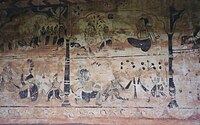
Alibag, also known as Alibaug, is a coastal city and a municipal council in Raigad district of Maharashtra, India. It is the headquarters of the Raigad district and is south of the city of Mumbai. Alibag is part of the Mumbai Metropolitan Region and is situated at a distance of about 96 km from Mumbai and 143 km from Pune.

Kanhoji Angre, also known as Conajee Angria or Sarkhel Angré was a Maratha Navy officer. Kanhoji became known for attacking and capturing European East Indiamen and collecting jakat, seen by Europeans traders and colonists as ransoming of their crews. British, Dutch and Portuguese ships often fell victims to these raids.Despite attempts by the Portuguese and British to put an end to his privateering activities, Angre continued to capture and collect jakat from European merchant ships until his death in 1729. Kanhoji's naval prowess in capturing dozens of European trading ships and avoiding capture has led to many historians to appraise Kanhoji as the most skilled Indian navy chief in the maritime history of India.

Shri Manguesh temple is Hindu temple, located at Mangeshi Village in Priol, Ponda taluk, Goa. It is at a distance of 1 km from Mardol close to Nagueshi, 21 km from Panaji the capital of Goa, and 26 km from Margao. Shree Mangueshi is the Kuldeva of Saraswat Brahmins and other gotras. Shrimad Swamiji of Shri Kavale Math is Spiritual chief Of Shri Manguesh Saunsthan, Mangueshi. This temple is one of the largest and most frequently visited temples in Goa.
Shirur is an administrative subdivision of the Pune district in the Indian state of Maharashtra. It is located on the eastern boundary of the district, on the banks of the Ghod River. The town is also called Ghodnadi to distinguish it from other locations that have the same name. Ghodnadi in Marathi Language means Ghod River.

Kolaba Fort located at Alibag beach is an old fortified maritime base in Alibag, Konkan, India. It is situated in the sea at a distance of 1–2 km from the shores of Alibag, 35 km south of Mumbai, in the Konkan region of Maharashtra, India. It is a popular tourist destination and a protected monument.

Devgad is a taluka in Sindhudurg district of Maharashtra, India consisting of 98 villages. It is located on the Arabian Sea in the coastal Konkan region of Maharashtra, south of Mumbai. Devgad is known globally for its exports of locally grown Alphonso mangoes.

Vijaydurg is a seaport 485 km from Mumbai on India's West Coast. It boasts a safe harbour with average depths in excess of 100 feet.

Vijaydurg, the oldest fort on the Sindhudurg coast, was constructed during the regime of Raja Bhoja II of the Shilahar dynasty and restructured by Shivaji.
Vadhav is a village in the tehsil/mandal of Pen in the Raigad district of Maharashtra.
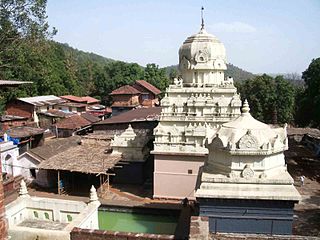
Parshuram Temple is a temple of Lord Parshurama, the sixth avatar of Vishnu in Hinduism located near Chiplun in Ratnagiri district of Maharashtra, India.
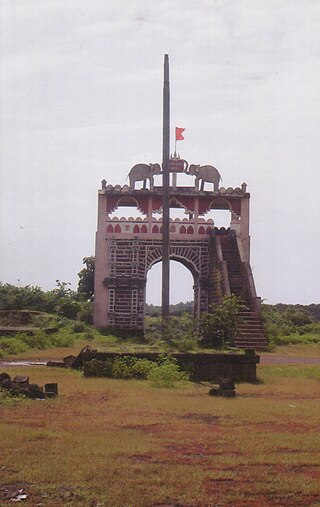
Rameshwar also known as Rameshwar Wadi is a small town located on the coast of Sindhudurg District of Maharashtra on the west coast of India. A very old Shri Dev Rameshwar Temple is located in this town which is dedicated to the Hindu deity Shiva.

Pujare, also known as Pujar, Pujara or Pujari, traditionally belonged to the priestly class of the Maratha community. They are the original inhabitants of Rameshwar in Devgad Taluka of Sindhudurg District in Maharashtra, India.
Girye is a small village in Devgad Taluka in Sindhudurg district of the Indian state of Maharashtra. It is located on the west coast of Maharashtra.
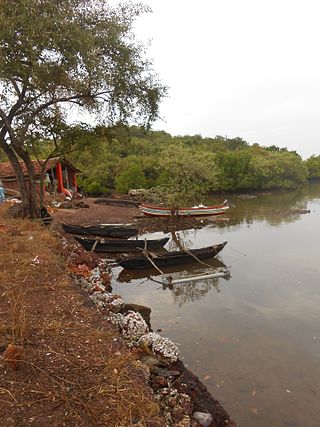
Rameshwar Dockyard also known as Rameshwar Godi (Marathi) is a small tidal dockyard located on the west bank of Waghotan River of Sindhudurg District of Maharashtra state on the west coast of India. It is a naval dockyard built by the Maratha Admiral Kanhoji Angre about 1.5 km from Vijaydurg Fort, used mainly for repair and maintenance of ships of the Maratha Navy. The dockyard currently lies on the outskirts of a small Christian Settlement and is used only for the purpose of fishing.

The Battle of Vijaydurg was fought between Tulaji Angre, the Admiral of the Maratha Navy and the combined forces of the East India Company and the Maratha Confederacy led by Peshwa Balaji Bajirao in early 1756.

Manikgad is a mountain fortress and temple in Gherakilla Manikgad, India. Located among rolling hills, the temple is a popular hiking spot. Manikgad was built to oversee the trade route from Maval (Pune) to coastal ports. The fort is situated near Vashivali, which is 27 km from Panvel.

The Maratha Navy was the naval wing of the armed forces of the Maratha Confederacy, which existed from around the mid-17th century to the mid-18th century in the Indian subcontinent.
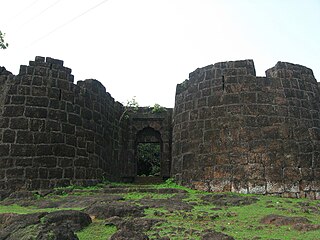
Bankot Fort / Himmatgad Fort/ Fort Victoria is a fort located 47 km from Dapoli, in Ratnagiri district, of Maharashtra. This fort is an important fort in Ratnagiri district. The Fort is located on a prominent and commanding point for guarding the trade route along the Savitri River, which runs till, Mahad which was a busy route in medieval times. It is a fort located on a hill near the sea.
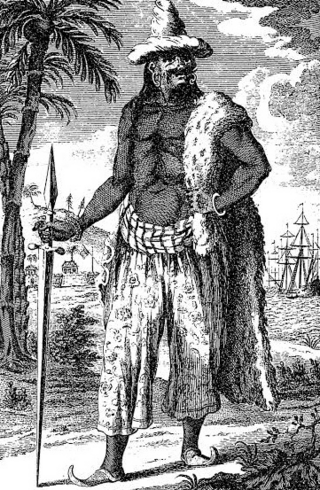
Tulaji Angre, called Tulajee Angria by English historians was the grand admiral of the Maratha Navy and ruler of Colaba State in modern-day India. Similar to his famous father Kanhoji Angre, he too was an extremely skilled admiral and attacked several European trading ships. His achievements and naval prowess are considered to be greater than that of his father by some scholars and chroniclers. On various occasions he fought against the English, Dutch, Siddis And Portuguese maritime Powers. However, he alienated himself from the Maratha Peshwa, Balaji Baji Rao which led to his capture by the East India Company and Peshwa's forces at the Battle of Vijaydurg in 1756.
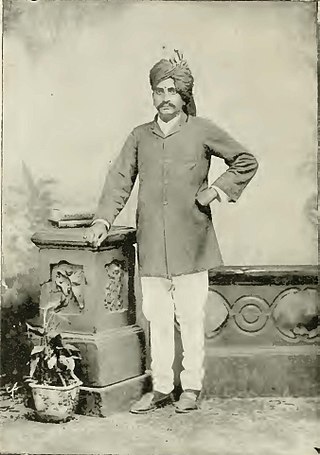
The Dhulap family was a Maratha noble family of the Maratha Empire in the late 18th century-early 19th century who were hereditary sarkhels or supreme commanders of the Maratha Navy during its decline. They came to power after the Angre family's downfall and Tulaji Angre's defeat at the Battle of Vijaydurg by the East India Company. Rudraji Dhulap and his son Anandrao Dhulap successively served as grand admirals of the Maratha Navy.





